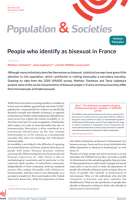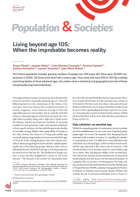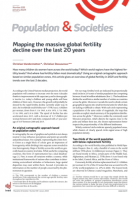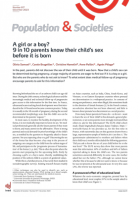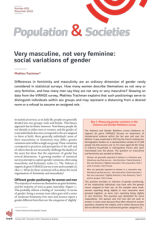
Very masculine, not very feminine: social variations of gender
Population and Societies
n° 605, November 2022
https://doi.org/10.3917/popsoc.605.0001
French Institute for Demographic Studies.
The majority of women see themselves as quite feminine, and the majority of men as quite masculine. This probably reflects a feeling of ‘normality’ in terms of gender: being a woman most often goes with a sense of moderate femininity. Yet, gender positionings are organized differently by the two sexes: while one-third of men report being ‘very masculine’, less than a quarter of women feel ‘very feminine’; just over 9% of women feel ‘not very feminine’, while just 2% of men feel ‘not very masculine’. Differences in gender variations between the sexes doubtless reflect a lower value attributed to what is female than to what is male, but also an uncertainty about what it means to be a man or a woman.
gender, sex, femininity, masculinity, gender norm, gender positioning, socio-economic category, overweight, VIRAGE survey
Table of contents
- Appendix A References
1.
Differences in femininity and masculinity are an ordinary dimension of gender rarely considered in statistical surveys. How many women describe themselves as not very or very feminine, and how many men say they are not very or very masculine? Drawing on data from the VIRAGE survey, Mathieu Trachman explains that such positionings serve to distinguish individuals within sex groups and may represent a distancing from a desired norm or a refusal to assume an assigned role.
In statistical surveys, as in daily life, people are generally divided into two groups: male and female. This binary approach has its limits, however. Non-binary people do not identify as either men or women, and the gender of trans individuals does not correspond to the sex assigned to them at birth. More generally, individuals’ sense of their masculinity or femininity may differ; gender variations exist within a single sex group. These variations correspond to practices and perceptions of the self and of others that do not necessarily challenge the duality of the sexes but show that the experience of gender has several dimensions. A growing number of statistical surveys attempt to capture gender variations, often using masculinity and femininity scales [1]. The Violences et rapports de genre [VIRAGE] survey is one such example [2] (Box 1). What do these variations tell us about the social organization of femininity and masculinity?
1.1. Box 1. Measuring gender variations in the Violence and Gender Relations survey
The Violence and Gender Relations survey (Violences et rapports de genre [VIRAGE]) focuses on experience of interpersonal violence within the last year and over the lifetime. It was conducted in 2015 by the French Institute for Demographic Studies on a representative sample of 27,268 people (15,556 women and 11,712 men) aged 20–69, living in ordinary households in metropolitan France who were interviewed over the phone. The question on masculinity and femininity was worded as follows:
Women are generally expected to behave in a feminine way. Would you say that you are… Very feminine / Quite feminine / Not very feminine / Slightly masculine / Very masculine / Don’t wish to answer / Don’t know.
Men are generally expected to behave in a masculine way. Would you say that you are… Very masculine / Quite masculine / Not very masculine / Slightly feminine / Very feminine / Don’t wish to answer / Don’t know.
This question provides an indicator of gender positioning, of the relationship individuals may have with the gender norms assigned to their sex. As the samples were small, women reporting being slightly or very masculine were grouped together, as were men reporting being slightly or very feminine. This question was distasteful for some respondents: 143 women and 154 men did not wish to answer, in some cases because they often refused to answer questions, whatever the subject, and in others because they did not identify with the mainstream gender categories [3].
1.1. Different gender positionings for women and men
The majority of women see themselves as quite feminine, and the majority of men as quite masculine (Figure 1). This probably reflects a feeling of ‘normality’ in terms of gender: being a woman most often goes with a sense of moderate femininity. Few men and women report a gender different from their sex: the categories of ‘slightly’ or ‘very’ feminine for men, ‘slightly’ or ‘very’ masculine for women, are rejected by most individuals. Yet, gender positionings are organized differently by the two sexes: while one-third of men report being ‘very masculine’, less than a quarter of women feel ‘very feminine’; just over 9% of women feel ‘not very feminine’, while just 2% of men feel ‘not very masculine’.
This finding can be interpreted in relation to the values attributed to femininity and masculinity. Differences in gender variations between the sexes doubtless reflect a lower value attributed to what is female than to what is male. Men more readily identify with a socially valued category, while women distance themselves from a discredited one. These gender variations may also signal a female distancing from gender norms seen as illegitimate or restrictive, those concerning the div, clothing, couple lifestyles, or sexual practices, for example. For both men and women, they may be the acknowledgement of a difference from the desired norm, or the expression of a difficult relationship with an imposed norm. To grasp the social signification of gender variations, we can look at which men feel slightly or very masculine and which women feel slightly or very feminine.
1.2. Gender as an expression of one’s div, occupation, or desire
Gender norms can be linked to physical and bodily appearance. Underweight men (measured via the World Health Organization’s div mass index) more often feel slightly or very feminine and not very masculine. Likewise, overweight women more often feel slightly or very masculine and not very feminine, although to a lesser extent (Tables 1 and 2). Gender positionings reflect widely shared representations of femininity and masculinity that may give rise to feelings of ‘deviance’; the div expresses gender, but in an opposite manner for men and women.
Among men, gender positioning is strongly influenced by educational level and occupational category (Table 1). The higher their level of education, the weaker their tendency to place themselves in the ‘very masculine’ category; while some report being ‘not very masculine’, they tend to opt for ‘quite masculine’. Occupational categories also partially reflect this tendency. Men in higher-level occupations less often say they are very masculine than male manual workers, farmers, and clerical workers.
This may not reflect a questioning of gender hierarchies, but rather the affirmation of a distinguished masculinity. Men not claiming to be very masculine might be using gender to make class distinctions, considering claims of unqualified masculinity as somewhat crude. Such attitudes are not necessarily linked to gender practices, however, or to a rejection of the male–female hierarchy [4]. This is evidenced by surveys on the division of domestic tasks, which show that upper-class men spend no more time on housework than working-class men [5].
Women’s gender positionings vary somewhat differently (Table 2). Education and occupational category have less weight: the positions and spaces that shape masculinity and femininity are not the same. That said, highly educated women and those in certain occupational categories, notably farmers and manual workers, less often say they are very feminine. This doubtless reflects the gendered dimension of certain occupations, associated with both masculinity and the working classes. Certain professional positions appear to heighten women’s unease with the femininity they see as ‘normal’ or, alternatively, may provide an escape from gender norms. Women may feel less feminine because they work in certain types of jobs or, on the contrary, deliberately work in occupations that distance them from norms of femininity.
Certain minority groups may have a specific relation to gender. This is the case for sexual minorities whose desire for people of the same sex was historically qualified as a gender inversion, thereby contributing to the widespread stereotype of the masculine lesbian woman and the effeminate gay man [6]. The gender positionings of people who identify as homosexual or bisexual are very different from those of heterosexuals. They vary by sex and sexual identification (Tables 1 and 2). While the ‘not very masculine’ category is shunned by men, including gay men, certain women, lesbian women especially, see themselves as ‘not very feminine’. Women who report as bisexual more often say they are not very feminine than heterosexual women, but a majority say they are quite feminine. This suggests that the high social value of masculinity is attractive to certain women, lesbian women especially, and that men, even gay men, find it difficult to distance themselves from it.
1.3. Questions around gender and sexuality
Gender positioning may depend not only on a long-term sense of identity but also on more specific experiences. Gender shapes many spheres of a person’s life, such as work and family, and sexuality is an area where the sense of masculinity or femininity is particularly important. This is illustrated by the gender differences in sexual socialization with regard to masturbation or pornography, for example, and, more broadly, in the socially differentiated conceptions of male and female sexuality. The VIRAGE survey recorded certain events experienced over the previous 12 months, such as arguments about sexuality, refusal to have sexual intercourse with one’s partner, and consent to intercourse despite not wanting it. Our analysis of these experiences based on VIRAGE data concerns heterosexuals with a partner at the time of the survey. It excludes sexual minorities, whose gender positionings, as we have seen, are very specific, and focuses on sexuality within a relationship (see online appendix, https://doi.org/10.34847/nkl.33da852d).
Men who say they are not very masculine are more likely than men who say they are quite or very masculine to have had arguments about their sexuality with their partner and, even more so, to have consented to intercourse without wanting it. These two latter groups are very similar in terms of these sexual experiences. The differences are less clear-cut for women. Those who say they are not very feminine are more likely to have refused intercourse with their partner, contrary to women who say they are very feminine, who refuse less often. The gender positionings of women and men are not characterized by the same sexual experiences. Moreover, differences in gender positioning are more closely linked to these experiences for the latter than for the former.
These results show that certain recent sexual experiences are more important for masculinity than for femininity. They also provide a better understanding of the individuals who distance themselves from the mainstream gender positioning and of the meaning of this distancing. Women who say they are not very feminine express their desires more clearly than the others. This positioning may reflect the affirmation of a certain sexual autonomy. This does not rule out compromise, however, as they also consent to intercourse when they do not really want it.
Men who say they are not very masculine are not distinctive in every respect; they do not more often report refusing sexual intercourse, for example. The norm whereby a man must always feel sexual desire remains pervasive here [7]. The higher frequency of arguments about sexuality and the more frequent consent to unwanted intercourse may be seen as an expression of difficulties between the partners. But for men, they may also signal a manner of considering the partner’s desires, of acknowledging disagreements on subjects that may be difficult to broach. In this respect, saying that one is not very masculine may signal a questioning of certain gender norms that most other men accept unthinkingly.
Asking individuals about their masculinity and femininity provides a means to capture differences between men and women beyond the limits of a comparison between sex groups. The question asked in the VIRAGE survey sheds some light on this dimension of gender, but more information is needed. It would be useful, for example, to ask men and women about both their masculinity and their femininity [1] and to record the diversity of opinions about gender norms.
Despite these limitations, the results presented here illustrate a relative diversity of gender positionings that are not necessarily associated with particular gender practices but that express ways of distinguishing oneself from other women or other men. For more women than men, gender is not self-evident, probably because they are more exposed to its downsides. For men, positionings are shaped more by their socio-economic category and certain sexual experiences: while valued, masculinity appears to be less stable. Distancing probably does not reflect a total rejection of gender norms, but rather ambivalence and uncertainty about what it means to be a man or a woman.
Appendix A References
-
[1] Magliozzi D., Saperstein A., Westbrook L., 2016, Scaling up: Representing gender diversity in survey research, Socius: Sociological Research for a Dynamic World, 2, 1–11.
-
[2] Brown E., Debauche A., Hamel C., Mazuy M. (eds.), 2020, Violences et rapports de genre. Enquête sur les violences de genre en France, INED.
-
[3] Trachman M., Lejbowicz T., 2018, Des LGBT, des non-binaires et des cases. Catégorisation statistique et critique des assignations de genre et de sexualité dans une enquête sur les violences, Revue française de sociologie, 59(4), 677–705.
-
[4] de Singly F., 1993, Les habits neufs de la domination masculine, Esprit, 196(11), 54–64.
-
[5] Champagne C., Pailhé A., Solaz A., 2015, Le temps domestique et parental des hommes et des femmes: quels facteurs d’évolutions en 25 ans ? Économie et Statistique, 478-479-480, 209–242.
-
[6] Murat L., 2006, La loi du genre. Une histoire culturelle du ‘troisième sexe’, Fayard.
-
[7] Ferrand M., Bajos N., Andro A., 2008, Accords et désaccords: variations autour du désir, in Bajos N., Bozon M. (eds.), Enquête sur la sexualité en France. Pratiques, genre et santé, La Découverte, 359–380.
-
[8] Trachman M., Appendix on the method and results of the regression analysis,
-
https://doi.org/10.34847/nkl.33da852d
The majority of women see themselves as quite feminine, and the majority of men as quite masculine. This probably reflects a feeling of ‘normality’ in terms of gender: being a woman most often goes with a sense of moderate femininity. Yet, gender positionings are organized differently by the two sexes: while one-third of men report being ‘very masculine’, less than a quarter of women feel ‘very feminine’; just over 9% of women feel ‘not very feminine’, while just 2% of men feel ‘not very masculine’. Differences in gender variations between the sexes doubtless reflect a lower value attributed to what is female than to what is male, but also an uncertainty about what it means to be a man or a woman.
605-Data for Figures (in French)
https://doi.org/10.34847/nkl.33da852d
Cite the article
Mathieu Trachman, Very masculine, not very feminine: social variations of gender, 2022, Population and Societies, no. 605
 This document may be reproduced free of charge on paper or online using our Creative Commons licence.
This document may be reproduced free of charge on paper or online using our Creative Commons licence.

